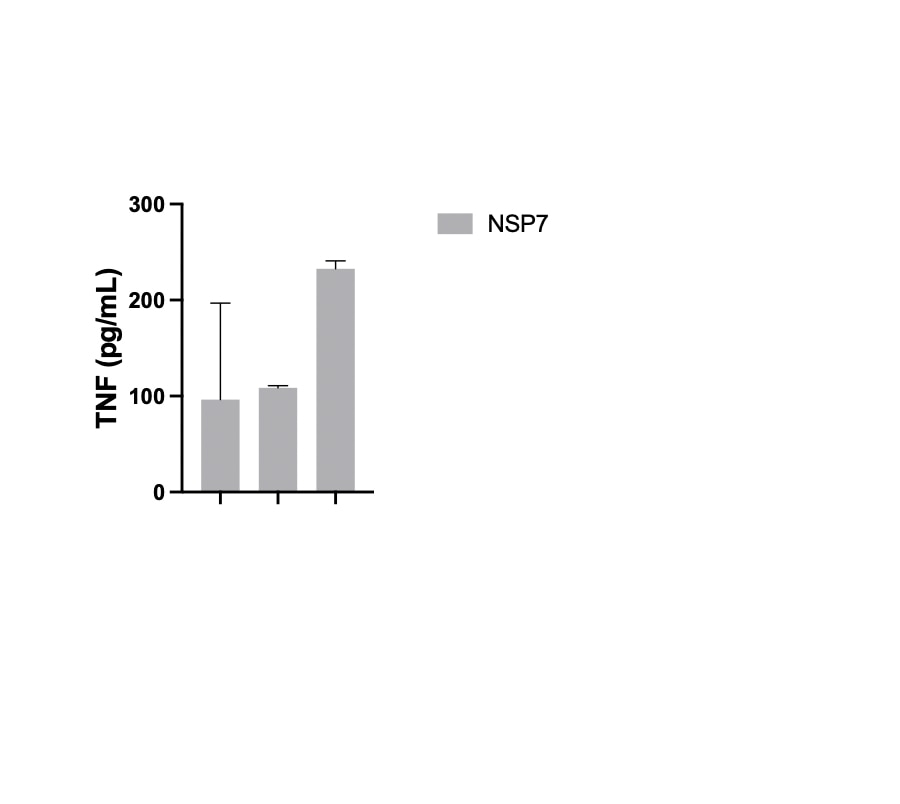Recombinant SARS-CoV-2 NSP7 His-tag Protein, CF Summary
- R&D Systems E. coli-derived Recombinant SARS-CoV-2 NSP7 His-tag Protein (10632-CV)
- Quality control testing to verify active proteins with lot specific assays by in-house scientists
- All R&D Systems proteins are covered with a 100% guarantee
Product Specifications
Ser1-Gln83
with C-terminal 3CP and 6-His tag
Analysis
Product Datasheets
Carrier Free
CF stands for Carrier Free (CF). We typically add Bovine Serum Albumin (BSA) as a carrier protein to our recombinant proteins. Adding a carrier protein enhances protein stability, increases shelf-life, and allows the recombinant protein to be stored at a more dilute concentration. The carrier free version does not contain BSA.
In general, we advise purchasing the recombinant protein with BSA for use in cell or tissue culture, or as an ELISA standard. In contrast, the carrier free protein is recommended for applications, in which the presence of BSA could interfere.
10632-CV
| Formulation | Supplied as a 0.2 μm filtered solution in HEPES, NaCl and TCEP. |
| Shipping | The product is shipped with dry ice or equivalent. Upon receipt, store it immediately at the temperature recommended below. |
| Stability & Storage: | Use a manual defrost freezer and avoid repeated freeze-thaw cycles.
|
Scientific Data
 View Larger
View Larger
2 μg/lane of Recombinant SARS-CoV-2 NSP7 His-tag (Catalog # 10632-CV) was resolved with SDS-PAGE under reducing (R) and non-reducing (NR) conditions and visualized by Coomassie® Blue staining, showing bands at 7-8 kDa under reducing conditions.
Reconstitution Calculator
Background: NSP7
Non-structural protein 7 (NSP7) is one of several functional proteins released by ORF1a-encoded protease cleavage of the pp1a and pp1ab replicase polyproteins expressed from the coronavirus (CoV) genome (1). The NSPs are involved in the replication and transcription of the viral RNA and not incorporated within the virion particles. Coronaviruses include various highly pathogenic strains such as SARS-CoV, MERS-CoV and SARS-CoV-2 that have had significant impact on humans in addition to strains that have negatively impacted livestock. NSP7 is a small 83 amino acid protein that is highly conserved across coronaviruses (1). The NSP7 monomers are composed of a central core N-terminal tri-helical bundle with an additional short C-terminal helix (2). The monomeric units associate to form a large hexadecameric structure with NSP8 (2) where layers of NSP7 fill the spaces in between NSP8 units. The supercomplexes are stacked to form a channel with electrostatic properties that could allow RNA to pass through the channel to facilitate efficient replication and transcription. The NSP7/NSP8 supercomplex was thereby proposed to function as a primase for the viral RNA-dependent RNA polymerase (RdRp), NSP12 (3). In SARS-CoV-2, the RdRp has been shown to have little activity without NSP8/7 as cofactors (4) making NSP7/NSP8 critical for viral polymerase activity. NSP7 has also been shown to interact with several other viral NSP proteins, including NSP5, NSP9, and NSP13 (5) as well as multiple host cell proteins involved in membrane trafficking, signaling, and electron transport including potential drug targets such as COMT and PTGES (6).
- Snijder, E.J. et al. (2016) Adv. Virus Res. 96:59.
- Zhai, Y. et al. (2005) Nat. Struct. Mol. Bio. 12:980.
- Subissi, L. et al. (2014) Antiviral Res. 101:122.
- Yin, W. et al. (2020) Science 368:1499.
- von Brunn, A. et al. (2007) PLoS One 2:e459.
- Gordon, D.E. et al. (2020) Nature 583:459.
Citation for Recombinant SARS-CoV-2 NSP7 His-tag Protein, CF
R&D Systems personnel manually curate a database that contains references using R&D Systems products. The data collected includes not only links to publications in PubMed, but also provides information about sample types, species, and experimental conditions.
1 Citation: Showing 1 - 1
-
Investigation of SARS-CoV-2 individual proteins reveals the in vitro and in vivo immunogenicity of membrane protein
Authors: Haystead, T;Lee, E;Cho, K;Gullickson, G;Hughes, P;Krafsur, G;Freeze, R;Scarneo, S;
Scientific reports
Species: Human
Sample Types: Whole Cells
Applications: Bioassay
FAQs
No product specific FAQs exist for this product, however you may
View all Proteins and Enzyme FAQsReviews for Recombinant SARS-CoV-2 NSP7 His-tag Protein, CF
Average Rating: 4 (Based on 1 Review)
Have you used Recombinant SARS-CoV-2 NSP7 His-tag Protein, CF?
Submit a review and receive an Amazon gift card.
$25/€18/£15/$25CAN/¥75 Yuan/¥2500 Yen for a review with an image
$10/€7/£6/$10 CAD/¥70 Yuan/¥1110 Yen for a review without an image
Filter by:

